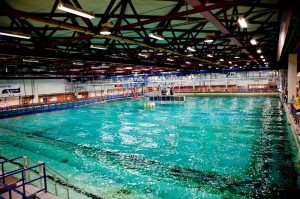Today we had the opportunity to visit the MARINTEK Lab, which is a test facility affiliated with NTNU and SINTEF in Trondheim, Norway. They specialize in research and development in the field of marine technology. The facility is comprised of two main basins with hydraulic systems that can create different wave conditions including long and short crested waves. There are only a few similar facilities in the world, and this is the only one in Norway. When we first entered the facility, they were testing a model boat in a set of wave conditions. They were able to move the boat along using a raised platform where researchers could sit with their computers. These particular experimenters were looking to gain data about the resistance on the boat and how it reacted with the waves along the edges. As our guide stated, they mostly test boats at this facility.
On the other side of the test facility we were able to see the type of equipment that that would be used on an offshore oil well. The apparatus would run between the oil seabed and the surface holding drilling equipment and piping. Although much of the research at MARINTEK is centered on oil and gas drilling platforms, where the real money is, they do some testing of offshore wind power. One particular aspect that our guide mentioned was testing the floating platforms that the offshore turbines sit upon, he mentioned research as early as 1980. One of the issues mentioned was that they cannot correctly simulate the aero forces that exist in the field. In order to combat this they mostly just test the part of the turbines that sits under the water. Our guide informed us that Norway is not doing too much research into offshore wind because of the exceptional amount of electricity that they are getting from hydropower. The focus on renewables is newer, and related to the oil drilling industry. Due to the offshore location of many of the drilling facilities, it is necessary for electricity to be run from land under the ocean in tubes. It would be a lot more convenient if turbines nearby could generate the electricity for these platforms.
In our class text MacKay talked briefly about offshore wind as well, particularly about the exceptional price. He stated that deep offshore wind is prohibitively expensive. This is likely another reason research and development of offshore wind turbines has been slow to come. However, it is important to have test facilities like MARINTEK in order to develop new technologies to reduce the cost of offshore wind in order to make them more competitive on the market. This way Norway and the world can transition into a more diverse mix of renewable, clean energy sources.


